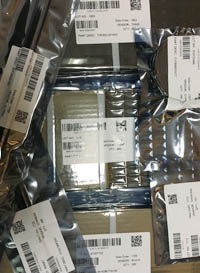| Part Number | MAX1090ACEI+ |
|---|---|
| Manufacturer | Maxim Integrated |
| Description | IC ADC 10BIT 400KSPS 28-QSOP |
| Datasheet | |
| Package | 28-SSOP (0.154", 3.90mm Width) |
| ECAD |
|
| In Stock | 2,000 piece(s) |
| Unit Price | $ 14.0190 * |
| Lead Time | Can Ship Immediately |
| Estimated Delivery Time | Apr 28 - May 3 (Choose Expedited Shipping) |
| Request for Quotation |
|
| Payment Methods | |
| Delivery Services |
Part Number # MAX1090ACEI+ (Data Acquisition - Analog to Digital Converters (ADC)) is manufactured by Maxim Integrated and distributed by Heisener. Being one of the leading electronics distributors, we carry many kinds of electronic components from some of the world’s top class manufacturers. Their quality is guaranteed by its stringent quality control to meet all required standards.
For MAX1090ACEI+ specifications/configurations, quotation, lead time, payment terms of further enquiries please have no hesitation to contact us. To process your RFQ, please add MAX1090ACEI+ with quantity into BOM. Heisener.com does NOT require any registration to request a quote of MAX1090ACEI+.
Bren*****Leon
April 3, 2023
Wil***** Leal
April 1, 2023
Ani*****Chang
March 30, 2023
Dant*****utista
March 24, 2023
Bla*****Wong
March 16, 2023
Sloa*****anders
March 12, 2023
Mela*****ixon
February 26, 2023
Rosi*****nnon
February 21, 2023





We guarantee 100% customer satisfaction.
Our experienced sales team and tech support team back our services to satisfy all our customers.

We provide 90 days warranty.
If the items you received were not in perfect quality, we would be responsible for your refund or replacement, but the items must be returned in their original condition.
| Part Number | Manufacturer | Description | Stock |
MAX1090ACEI+ D# MAX1090ACEI+ |
Maxim Integrated Products |
ADC Single SAR 400ksps 10-bit Parallel 28-Pin QSOP - Bulk (Alt: MAX1090ACEI+) |
0 |
MAX1090ACEI D# MAX1090ACEI |
Maxim Integrated Products |
ADC Single SAR 400ksps 10-bit Parallel 28-Pin QSOP - Bulk (Alt: MAX1090ACEI) RoHS: Not Compliant
|
0 |
MAX1090ACEI+T D# MAX1090ACEI+T |
Maxim Integrated Products |
ADC Single SAR 400ksps 10-bit Parallel 28-Pin QSOP T/R - Tape and Reel (Alt: MAX1090ACEI+T) |
0 |
| Part Number | Manufacturer | Description | Stock |
MAX1090ACEI+T D# MAX1090ACEI+T |
Maxim Integrated Products |
ADC Single SAR 400ksps 10-bit Parallel 28-Pin QSOP T/R (Alt: MAX1090ACEI+T) |
0 |
MAX1090ACEI+ D# MAX1090ACEI+ |
Maxim Integrated Products |
ADC Single SAR 400ksps 10-bit Parallel 28-Pin QSOP (Alt: MAX1090ACEI+) |
0 |
| Part Number | Manufacturer | Description | Stock |
MAX1090ACEI+T |
Maxim Integrated Products |
ADC SGL SAR 400KSPS 10-BIT PARALLEL 28QSOP - Tape and Reel |
0 |
MAX1090ACEI+ |
Maxim Integrated Products |
N/A 8-CH 10-BIT SUCCESSIVE APPROXIMATION ADC, PARALLEL ACCESS, PDSO28 QSOP-28 |
19 |
| Part Number | Manufacturer | Description | Stock |
MAX1090ACEI+T D# MAX1090ACEI+T-ND |
Maxim Integrated Products |
IC ADC 10BIT SAR 28QSOP |
0 |
MAX1090ACEI+ D# 2156-MAX1090ACEI+-ND |
Rochester Electronics LLC |
MAX1090 400KSPS, +5V, 8-CHANNEL, |
250 |
MAX1090ACEI D# 2156-MAX1090ACEI-MA-ND |
Rochester Electronics LLC |
8-CHANNEL, 10-BIT ADC |
19 |
| Part Number | Manufacturer | Description | Stock |
MAX1090ACEI+T |
Maxim Integrated Products |
400ksps, +5V, 8-/4-Channel, 10-Bit ADCs with +2.5V Reference and Parallel Interf RoHS: Compliant
pbFree: Yes
|
0 |
MAX1090ACEI+ |
Maxim Integrated Products |
400ksps, +5V, 8-/4-Channel, 10-Bit ADCs with +2.5V Reference and Parallel Interf RoHS: Compliant
pbFree: Yes
|
0 |
| Part Number | Manufacturer | Description | Stock |
MAX1090ACEI |
MAXIM INTEGRATED PRODUCTS |
OEM/CM QUOTES ONLY | NO BROKERS |
153 |
| Part Number | Manufacturer | Description | Stock |
MAX1090ACEIT |
Maxim Integrated Products |
OEM/CM ONLY |
422 |
MAX1090ACEI |
Maxim Integrated Products |
OEM/CM ONLY |
423 |
| Part Number | Manufacturer | Description | Stock |
MAX1090ACEI+ D# 700-MAX1090ACEI |
Maxim Integrated Products |
Analog to Digital Converters - ADC 400ksps, +5V, 8-/4-Channel, 10-Bit ADCs with +2.5V Reference and Parallel Interface RoHS: Compliant
|
92 |
| Part Number | Manufacturer | Description | Stock |
MAX1090ACEI+T D# NS-MAX1090ACEI+T |
Maxim Integrated Products |
OEM/CM ONLY |
5258 |
MAX1090ACEI+ D# NS-MAX1090ACEI+ |
Maxim Integrated Products |
OEM/CM ONLY |
4549 |
MAX1090ACEI D# NS-MAX1090ACEI |
VARIOUS |
OEM/CM ONLY |
2557 |
| Part Number | Manufacturer | Description | Stock |
MAX1090ACEI+ |
Maxim Integrated Products |
MAX1090 400Ksps, +5V, 8-Channel, 10-Bit ADC With +2.5V Reference and Parallel Interface RoHS: Compliant
|
250 |
MAX1090ACEI |
Maxim Integrated Products |
MAX1090 400Ksps, +5V, 8-Channel, 10-Bit ADC With +2.5V Reference and Parallel Interface RoHS: Not Compliant
|
19 |
| Part Number | Manufacturer | Description | Stock |
MAX1090ACEI+ |
Maxim Integrated Products |
OEM/CM ONLY |
198 |
Heisener's commitment to quality has shaped our processes for sourcing, testing, shipping, and every step in between. This foundation underlies each component we sell.

Do you have any question about MAX1090ACEI+?
+86-755-83210559 ext. 805



Scan to view this page